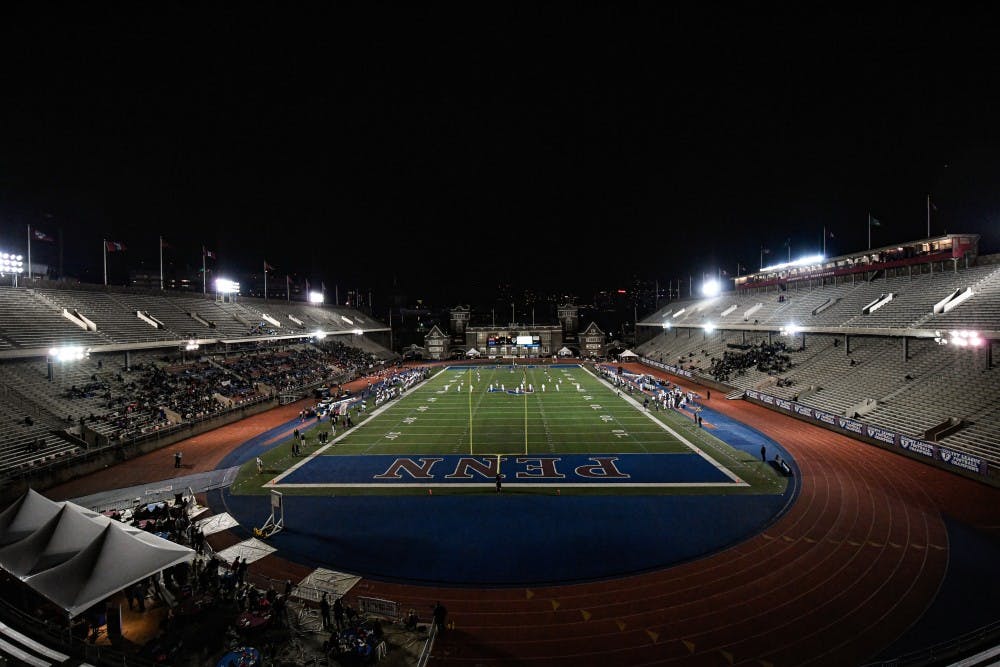It's never exciting to play at home in front of an empty stadium.
Overall, college football has seen a steady decline in game attendance, and Penn is all too familiar with this issue.
For the seventh time in eight years, national college football attendance has fallen. While 41,856 seems like a large number, this marks an all-time low since 1996 for average college football attendance among all 129 FBS programs last season.
“Traditionally, we see spikes in student attendance for the first game of the season — a game that coincides with Family Weekend — and Homecoming," said Mike Honeywell, Penn's director of ticket sales & service. "Overall, attendance is traditionally higher in years where Princeton travels to Franklin Field."
During the 2018 season, the Red and Blue only surpassed the 10,000-fan mark twice. These were games against Yale and Harvard, which had 10,126 and 13,224 fans, respectively.
For the Penn-Princeton rivalry game, only 7,756 people filed into the stands. This marks a stark decline from 2017's Penn-Princeton game, where 9,073 fans attended.
While Penn placed second in the Ivy League — behind only Harvard — at an average of 7,768 people per home game, the national champion Clemson Tigers averaged a whopping 80,400 people per home game at Death Valley.

In 2016 — the last time Penn football won a title — the average home game attendance was 5,560 people per game, which marked the third lowest weekly attendance in the Ancient Eight. Even in a year, when the Quakers were able to win a title, they still struggled to fill the stadium.
This could be due in part to Ivy League rules, which stipulate that teams can only play 10 games each season. Clemson and Alabama each played 150% of the games Penn did last season. While the rule was initiated to lower the risk of concussions, it also leaves fans fewer opportunities to make it out to games.
In 2009, the Red and Blue averaged 10,600 people per game, which placed them third among Ivies behind Harvard and Yale. The title-winning Alabama Crimson Tide averaged 92,012 people per game that same year.
During the rivalry game of Penn-Princeton in 2009, 14,027 fans showed up to Franklin Field — a sharp increase from recent years.
In the last decade, Penn football has seen a drop of about 3,000 fans per game. While the average for the Red and Blue in 2009 was about 10,000 fans per game, they only surpassed that number twice last season.
Another issue for the Quakers and the Ivy League is the lack of postseason play. The Ivy League has a rule in place that doesn’t allow for college playoffs, so an Ivy League squad's season finishes with the end of the regular season.
Without a higher goal than the League title to play for, it may be harder to draw a large crowd, especially for teams who are eliminated early from contention. It's tough for the casual fan with no tie to the University to be interested in the Quakers with no chance of seeing the team compete beyond Thanksgiving.
One way the football program is testing attendance levels is by experimenting with different start times for the games.
“Over the past two seasons, we have also taken a deeper look into how kickoff times impact our attendance numbers," Honeywell said. “Our data shows that Penn football games draw better at two times in particular: Friday nights and Saturdays at 1 p.m. With this in mind, our kickoff times this season are all set for either 1 p.m. or 1:30 p.m. on Saturdays, with the exception of the Dartmouth game on Friday night."
Additionally, this trend is somewhat due to the rise of sports media. While attendance at games has been down, television ratings are stronger than ever; many fans don’t see the benefit of going to a game when they could watch it from the comfort of their own home.
Another issue for the Red and Blue is the lack of fans showing up to multiple games in a season. The football program is trying out new programs this season like multi-game ticket packages in order to entice fans to show up to games.
“Historical data has shown that we have a number of fans that attend multiple football games [but] do not buy season tickets," Honeywell said. “With this in mind, we created the Red [and] Blue package, an option which bundles the Sacred Heart and Cornell games together at a discounted rate. This allows our fans to attend both Homecoming and one additional game at a more affordable rate, which should hopefully boost attendance for both games."
Even though nationwide college football attendance is dropping, Penn is determined to find innovative ways to draw fans to Franklin Field.









